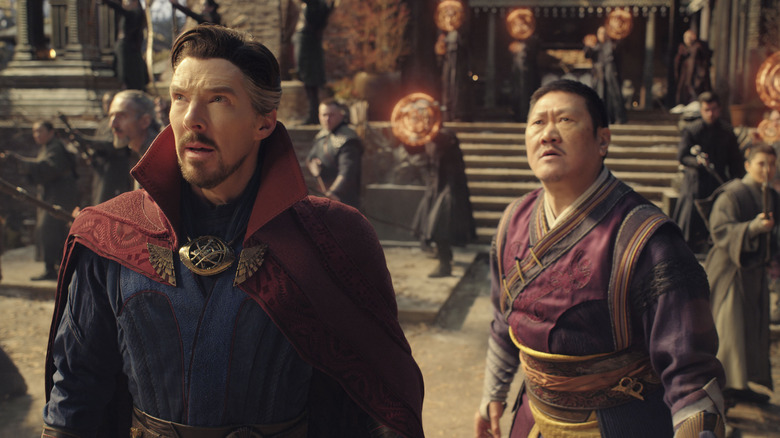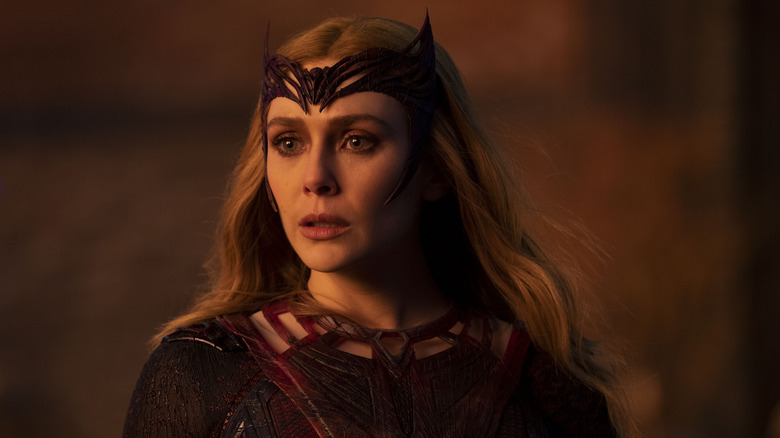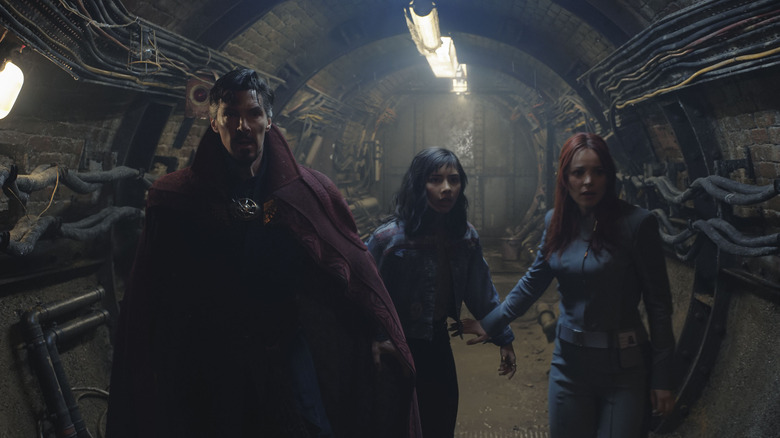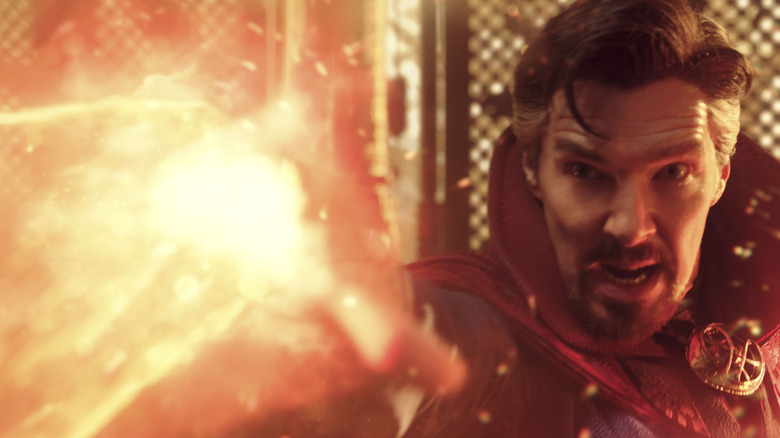Doctor Strange In The Multiverse Of Madness Spoiler Review: Half Of A Fun Sam Raimi Movie
"Are you happy?" It's a question that is asked both of and by Doctor Stephen Strange (Benedict Cumberbatch) throughout the new Marvel Cinematic Universe entry "Doctor Strange in the Multiverse of Madness." The simplicity of the question could just as easily be posed to a certain subset of film fan — those of us who may be a bit more intrigued by the umpteenth MCU movie not for the presence of Cumberbatch or Elizabeth Olsen as Wanda Maximoff, but for the man behind the camera, director Sam Raimi. It's been nine years since his last film, and the wait has been particularly rough. But can someone who loves Raimi's original "Spider-Man" films or his horror classics "The Evil Dead" and "The Evil Dead 2" find happiness in the gifted auteur working again with Marvel, but now in its assembly-line phase? The answer, as is the case within the film, is more complicated than a simple yes or no.
There is good news to be had in "Doctor Strange in the Multiverse of Madness," specifically in the form of Raimi a director. You don't have to look hard for creative flourishes that either feel like deliberate nods to his past work, or extensions of his distinctive visual style. There's a book of pure evil that might as well be called the Necronomicon. There are some genuine attempts at jump scares (though calling this an out-and-out horror film is extremely generous), and more violence than some audiences may expect from a Marvel movie, as cartoonish as that violence may be. And there's a point-of-view camera, courtesy of cinematographer John Mathieson, that's employed often in the second half to denote squirrelly, inexplicable, and unpredictable attacks of dark fantasy.
But where Raimi's "Spider-Man" films didn't have to bear the burden of being part of a larger franchise, "Multiverse of Madness" obviously does not have that luxury. Far be it from me to tell you what to watch or not watch in advance of this film, but just as this film is depicting the split of the multiverse through its lead characters, it too is split. It's a "Doctor Strange" sequel. It's a "WandaVision" sequel. It's a "Doctor Strange" and a "WandaVision" sequel.
A mother scorned
Since this is a spoiler review, I can freely speak about what Marvel is treating like a big spoiler: Wanda Maximoff is the villain of this film, a creative choice that has been kept as secret as these things get. The first time we meet her, it's a ruse that she tries to pull on Doctor Strange to make it look like her life is back to normal. But no, that same scene quickly reveals that she's lying through her teeth. If you recall the post-credits scene in the finale of "WandaVision," you may not be terribly surprised: she's seen there reviewing the pages of the aforementioned book of pure evil, the Darkhold, which she's now using to capture America Chavez (Xochitl Gomez), a teenager from another dimension who can jump between universes without any fuss. Using that power would send Wanda to another universe where she can reunite with her made-up children Billy and Tommy.
It should be noted that while the entirety of "Doctor Strange in the Multiverse of Madness" is ... y'know, fine, the first 40 to 50 minutes are where the film struggles to click into place. Part of it is that we are thrown into the situation with Doctor Strange and Wong (Benedict Wong) trying to protect America from Wanda as she morphs more fully into her Scarlet Witch mode. Though you can't blame Michael Waldron's script for dawdling over the finer details or setup, it all feels very rushed and disjointed until Strange experiences the effects of America's powers, as the two of them travel through a series of universes before arriving in one later dubbed 838. (The MCU universe is dubbed 616.) Once the duo arrives in 838, the movie is able to breathe a bit by honing in on two plots. In one, Strange and America try to figure out how to return to universe 616 and stop Wanda; in the other, Wanda, having lost the Darkhold during a savage attack on Kamer-Taj, the temple where Wong reigns as Sorcerer Supreme, drags Wong with her to the original location of the spells written down in the Darkhold.
The real advantage here is that, by focusing on each of these plots and taking more time to do so, Raimi is able to re-flex his horror muscles within the superhero world. Though no one should work overtime to presume that this movie is as terrifying or wild as the "Evil Dead" films or "Drag Me To Hell," the various nods to these films and the ways in which Raimi seems to delight in upending some traditional expectations of superhero movies and bending the PG-13 rating any way he can work in his favor.
Meet the Illuminati
As I write these words in advance of its release, it's difficult to know how people will respond to the film, but I feel comfortable assuming the extended setpiece where Strange meets Universe 838's version of the Avengers — dubbed the Illuminati — and they are then almost all promptly dispatched gruesomely by Scarlet Witch is going to inspire a bit of chatter. Part of it is the various names involved in the scene, from Patrick Stewart as Professor X to John Krasinski fulfilling a social-media fantasy and playing Mr. Fantastic. But it's the whole "Wanda kills a lot of superheroes" part that makes the sequence stand out. We know that the MCU version of Doctor Strange is an arrogant jerk who's confidence outpaces his intelligence. (America briefly notes that his plan to bring Wanda into the fold to help just allows the Scarlet Witch to locate the teenager quicker.) But so too are the Illuminati. One minute, they're laughing off the threat of the Scarlet Witch. The next, they're getting sliced into pieces, impaled by their own shields, crushed, or killed from within their own heads. (I don't know Black Bolt from a hole in the ground, but for a guy whose voice can kill, it's nasty to make him inadvertently kill himself as the Scarlet Witch does.)
The same sense of morbid fun arrives as the MCU version of Strange and the 838 version of Christine are booted into a grim variant of the universe in which both another Sanctum and Doctor Strange exist within a hollowed-out New York full of buildings melting in on themselves. This is where "Doctor Strange in the Multiverse of Madness" is at its strongest: in presenting odd, quirky images, even as many of those odd, quirky images are remixes or rehashes, either of the director's past work or of other directors' past work. (Though it's creepier to look at, much of this feels reminiscent of the final dream layer in Christopher Nolan's "Inception.")
Because as is often the case, there are few, if any, character arcs in this movie. That question at the top of this spoiler review — "Are you happy?" — is kind of it. There's initially some sense that the film will also explore Doctor Strange's doubt of whether or not the play to let Thanos snap half of humanity out of existence for five years was the right move. But primarily, it's just whether or not Strange is happy (he's clearly not) and what would make him happy (being with Christine, even though he knows he can't be). America's arc is learning to trust herself and this iteration of Strange. Wanda's arc is to, just as we thought she did by the end of "WandaVision," accept that Vision is dead and that her made-up children — even though they aren't real — don't perceive the Scarlet Witch as anything other than a terrifying ... y'know, scarlet witch.
That also ties into what could be a harder problem to shake moving forward (or at least serves as a key issue for this film): where does this film fit into the larger puzzle of whatever comes next for the MCU? There was a time not so long ago when a film within the Marvel Cinematic Universe, such as the original "Guardians of the Galaxy," managed to be creatively successful without feeling like you had to watch every previous MCU film first was a point in its favor. "Doctor Strange in the Multiverse of Madness" is far from being this kind of movie, serving as a sort of epilogue to Wanda's grief for Vision and an epilogue for Doctor Strange and his presumed doubt over what led to the Snap.
But because of that, and because the film repeats the basic emotional threads we've already seen, the movie has little forward motion, even for a film about the prospect of infinite universes. (Perhaps because of the ramifications of the finale of "Spider-Man: No Way Home," there's not a ton of mention about the events of that film, outside of America cracking a joke about how gross a superhero named Spider-Man sounds.) The closest we get to forward motion is the conclusion of Wanda's story (for now). After a big battle with America, she's confronted with the heartbreaking reality that as much as she sees herself as a mother, the versions of Billy and Tommy she dreams about (those who exist in another universe) see their Wanda as their mother, not her. So she renounces her claim on America's gift and sacrifices herself, though the way these movies work, that likely means she'll be back in, like, 18 months or something in whatever amounts to a new "Avengers" movie. Hopefully next time, Olsen can be given a richer character to work with than just hissing "I'm a mother" at anyone who will listen.
The big finish
Doctor Strange, meanwhile, goes back home but learns that when he, too, used the Darkhold and put himself in his dead corpse (who was previously a ponytailed version of himself seen in the opening moments), there was a price for him to pay ... in the form of a literal third eye bursting out of his forehead before the film cuts to its end credits. It's an odd way to end the movie, but feels weirdly in keeping with Raimi's predilection for body horror — even if this is a far cry from so many of Raimi's horror films.
More inexplicable is the first of two scenes in the credits, as Doctor Strange is accosted on a city street by a stranger opening a portal to another universe, demanding that he help fix the mysterious damage he caused. As he dons his cape and opens his third eye, he happily joins said stranger ... and oh, by the way, said stranger is played by Charlize Theron. Now, the credits tell me Theron plays a character named "Clea," and some of my fellow critics/comic-book nerds have told me Clea is a fellow sorcerer who serves as Strange's love interest in the comic books, which ... uh ... sure! OK! I like Charlize Theron just fine, and hopefully, she's better used in this franchise than she is in the "Fast and Furious" films (because I feel safe in assuming she's going to return in upcoming movies). But as the movie ends with a shrug, so too does this scene.
There's something a little too on-the-nose yet admittedly funny about the way this movie truly ends. We return to something I knew was coming upon sitting down to watch "Doctor Strange in the Multiverse of Madness": a cameo from Bruce Campbell, Raimi's longtime collaborator. Campbell plays a jerky street vendor from universe 838 who Strange curses to hit himself for three weeks, in one of the true laugh-out-loud bits of the film. As the film cuts back to Campbell at the very end, those three weeks have elapsed. As bruised as he is, he's delighted when he no longer is forced to hit himself (in a gag that has sly shades of his work in the "Evil Dead" films). So Campbell looks right at the camera and says, "Ha! It's over!"
Now, I'm not here to say that the experience of watching "Doctor Strange in the Multiverse of Madness" is akin to punching yourself in the face for two straight hours. It's kind of fun! But it is far less fun when Sam Raimi is forced to hit the beats that Kevin Feige and the MCU brain trust had likely pre-scripted long before the auteur joined the project. There are bits and pieces, especially in the second half, that work like gangbusters. But there is also the gratifying sense when it ends that you can head out of the multiplex and back into the fresh air. This movie has its moments, as many MCU films do. But the sense of obligation, of needing to watch these things to keep up with modern pop culture, is getting to feel a little more painful with each day.



